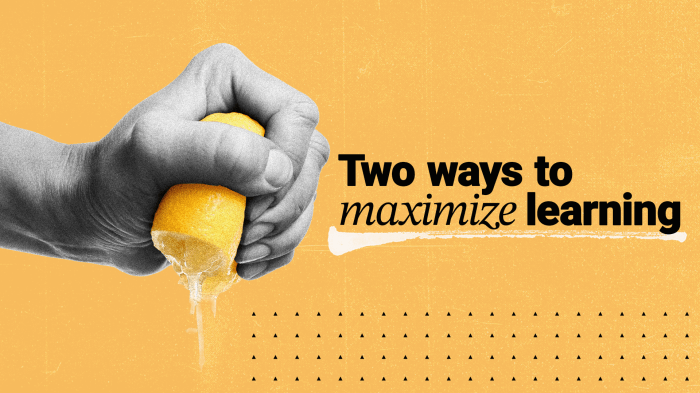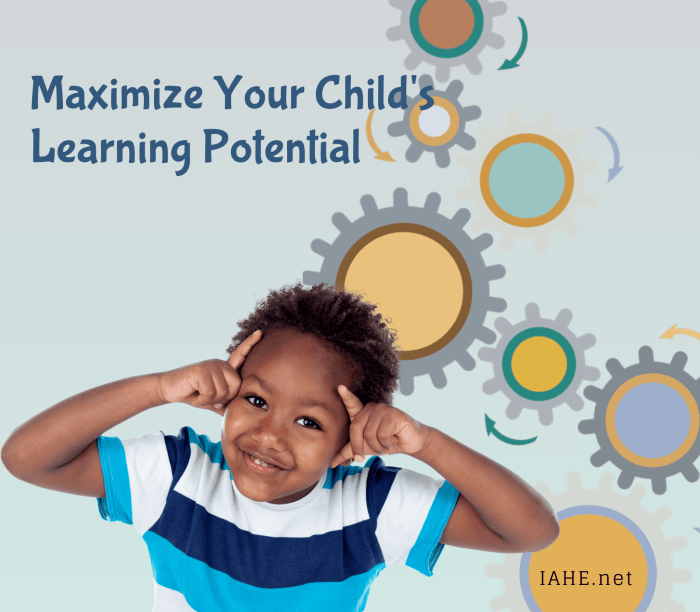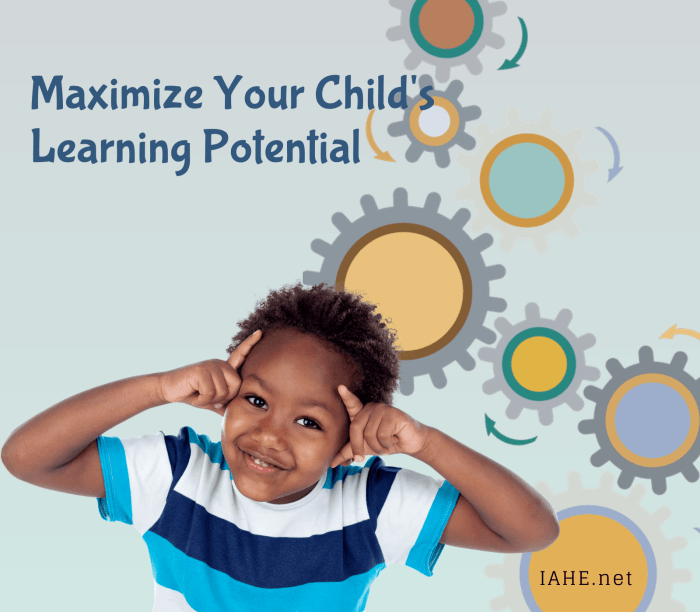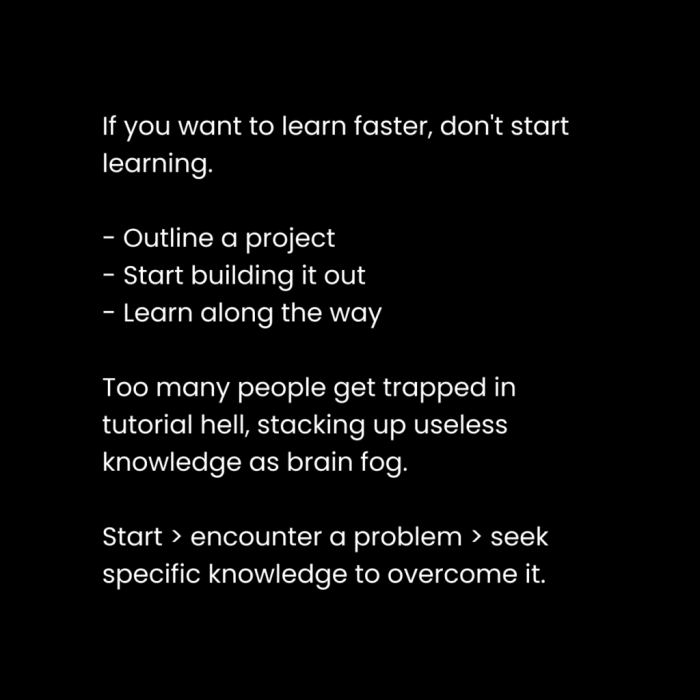Why aiming for less than 100 can optimize learning? This isn’t about aiming low, but about focusing deeply. Learning a vast subject can feel overwhelming. Instead, concentrate on mastering a specific skill or a smaller area of knowledge. This focused approach leads to deeper understanding, better retention, and a greater sense of accomplishment.
Think of it like building a solid foundation—one brick at a time—instead of trying to construct a skyscraper in one go. This method boosts motivation and makes the learning process much more enjoyable.
This exploration dives into the strategies for achieving optimal learning outcomes by limiting your scope. We’ll discuss how focusing on specific learning objectives, effectively managing resources, and maintaining motivation are key to success. Furthermore, we’ll consider how these strategies can be adapted to different learning styles, ensuring everyone can benefit from this powerful approach. The content is designed to empower learners with practical tools and insights.
Understanding the Concept of Limiting Goals
Setting learning goals is crucial for progress, but the scope of those goals significantly impacts the learning journey. Focusing on a narrow, well-defined target can be surprisingly effective, leading to deeper understanding and a stronger sense of accomplishment than trying to grasp everything at once. This approach fosters sustained motivation and prevents feelings of overwhelm.Limited goals allow learners to delve deeper into specific areas of knowledge or skill, building expertise rather than superficial familiarity.
This targeted approach contrasts with the often-unachievable aspiration of comprehensive understanding across vast fields, which can lead to frustration and diminished motivation. By focusing on mastery within a defined boundary, learners experience a more manageable and rewarding learning process.
The Power of Specific Learning Goals
Setting specific, limited goals allows for a focused and strategic approach to learning. Instead of aiming for “knowing everything about history,” a learner might target “mastering the causes of World War I.” This precision fosters a deeper understanding of the subject matter, as the learner actively seeks to grasp the intricate connections and nuances within the limited scope. Examples of this targeted approach include mastering a particular coding language, perfecting a specific musical instrument technique, or becoming proficient in a certain mathematical algorithm.
Comparing Unlimited vs. Limited Goals
The difference between unlimited and limited goals manifests in the learner’s experience. An unlimited goal, aiming for comprehensive knowledge, often leads to feeling overwhelmed, especially when facing a large body of information. The learner may struggle to stay motivated and experience diminishing returns. In contrast, a limited goal, focusing on mastering a specific skill or concept, fosters a sense of accomplishment with each step forward.
This incremental progress boosts motivation and encourages further learning.
Psychological Benefits of Limited Goals, Why aiming for less than 100 can optimize learning
Setting smaller, achievable learning targets has significant psychological benefits. The sense of accomplishment derived from mastering a specific skill or understanding a complex concept directly contributes to increased self-esteem and confidence. Limited goals also reduce feelings of anxiety and overwhelm, fostering a more positive and productive learning environment. This, in turn, can lead to a greater willingness to tackle more challenging tasks in the future.
The Relationship Between Ambitious vs. Specific Goals
Ambitious goals, while inspiring, can often lack the crucial element of specificity. This vagueness can lead to a lack of direction and make it difficult to track progress. In contrast, specific goals provide a clear roadmap for learning, allowing learners to monitor their progress and adjust their strategies as needed. This focused approach to learning often results in higher motivation and more effective learning outcomes.
Learning Approaches and Limited Scope
Different learning approaches can benefit from a limited scope. The table below Artikels various methods and how limiting the scope can optimize learning:
| Learning Approach | Potential Benefits of Limiting Scope |
|---|---|
| Reading | Focusing on a specific author, genre, or historical period can lead to deeper comprehension and analysis. |
| Coding | Mastering a particular programming language or framework allows for the development of practical skills. |
| Music | Concentrating on a specific instrument or musical style fosters technical proficiency and artistic expression. |
| Language Learning | Focusing on conversational skills within a specific context, like travel or business, can lead to rapid progress. |
| History | Studying a particular historical event or period, rather than trying to learn everything, leads to a deeper understanding of cause and effect. |
Optimizing Learning Through Focus

Focusing your learning efforts on a smaller, well-defined area allows you to delve deeper and grasp concepts with greater clarity. This targeted approach strengthens your understanding, improves retention, and ultimately boosts your overall learning effectiveness. By limiting the scope, you create space for focused attention and sustained effort, crucial elements for mastering any subject.Learning is often a multifaceted endeavor, with many competing demands on our time and attention.
Focusing on fewer than 100 tasks at a time can be a game-changer for boosting learning efficiency. It’s about quality over quantity, and that applies to everything, from studying to mastering a new recipe. Choosing the right supplements, like flaxseed oil vs fish oil, can also impact cognitive function. The key is finding the perfect balance between what you can realistically tackle and maximizing your learning potential, ensuring you get the most out of every session.
flaxseed oil vs fish oil By streamlining your approach, you’re less likely to get overwhelmed and can better absorb and retain the information you’re working with, leading to significant improvements in your learning outcomes.
By intentionally narrowing your learning objectives, you can create a more conducive environment for deeper comprehension and lasting knowledge. This focused approach to learning is particularly valuable in today’s world, where distractions are abundant. This deliberate limitation of scope allows you to hone your skills and build a solid foundation of knowledge within a specific area.
Ways Limiting Scope Promotes Focus
A well-defined learning scope fosters focus and attention by reducing cognitive overload. Instead of trying to absorb a vast amount of information simultaneously, you concentrate on a manageable set of learning objectives. This allows your brain to process and retain information more effectively. The limited scope minimizes distractions and allows you to dedicate your mental resources to a particular subject area, leading to more profound learning outcomes.
Cognitive Benefits of Concentration
Concentrated learning on a specific subject area yields significant cognitive benefits. It enhances memory consolidation, leading to better recall and retention of information. By focusing on a particular domain, you’re strengthening neural pathways related to that subject, creating a more robust and accessible knowledge network. This focused learning also improves problem-solving skills and critical thinking, as you develop a deeper understanding of the subject’s intricacies.
Designing a Focused Learning Plan
Creating a learning plan that prioritizes a limited set of learning objectives is essential for optimized learning. A well-structured plan should include specific, measurable, achievable, relevant, and time-bound (SMART) goals. This structured approach ensures a clear path for your learning journey and enables consistent progress.
Deliberate Practice in a Specific Domain
Deliberate practice, focused on improving specific skills within a chosen domain, is crucial for mastery. This involves practicing specific techniques, analyzing mistakes, and seeking feedback to refine your approach. The practice needs to push you beyond your comfort zone, demanding attention to detail and fostering a deeper understanding.
Breaking Down Large Tasks
Breaking down large learning tasks into smaller, manageable chunks is crucial for sustained motivation and progress. This approach avoids feeling overwhelmed and allows you to celebrate smaller victories, which reinforces your commitment to the learning process. By tackling manageable sections, you’re more likely to stay engaged and achieve your learning objectives.
Focusing on a smaller learning goal, say less than 100 items to master, can be incredibly effective. It forces you to concentrate on quality over quantity, leading to deeper understanding. This principle, surprisingly, mirrors the dedication required in long-distance relationships, which, as highlighted in 21 best tips making long distance relationship work , demands consistent effort and prioritization.
Ultimately, both situations highlight that less can often mean more when it comes to achieving meaningful results.
Example Learning Plan
| Learning Objective | Allocated Time | Assessment Criteria |
|---|---|---|
| Mastering the fundamentals of calculus | 4 weeks | Successfully completing practice problems, achieving 80% accuracy on quizzes, and demonstrating understanding of key concepts in class discussions. |
| Improving Python programming skills | 6 weeks | Completing at least 3 projects, showcasing code functionality, and successfully debugging errors. |
| Deepening understanding of Renaissance art | 8 weeks | Creating detailed summaries of artworks, participating in discussions on art history, and demonstrating the ability to connect artistic movements to their historical context. |
Managing Learning Resources Effectively
Focusing on a smaller, manageable learning goal set requires a strategic approach to resources. Simply consuming vast amounts of information won’t necessarily lead to deeper understanding. Effective resource management involves discerning what’s truly essential for achieving your targeted learning objectives and discarding the rest. This approach fosters a more focused and efficient learning experience, ultimately leading to more profound insights.Learning effectively hinges on carefully curating your learning resources.
Overwhelm from an abundance of material can hinder comprehension and retention. By strategically selecting and prioritizing resources, you can channel your energy towards the most impactful information, maximizing your learning potential.
Selecting Relevant Learning Resources
A crucial aspect of effective resource management is the ability to discern relevant information from extraneous details. This involves clearly defining your learning objectives and then identifying resources directly aligned with those objectives. Avoid getting sidetracked by tangential information that might seem interesting but doesn’t directly contribute to your goals. Instead, focus on resources that directly address the specific knowledge or skills you aim to acquire.
This targeted approach ensures that your learning efforts are well-directed and productive.
Limiting Resources for Enhanced Learning
A smaller, curated selection of resources can lead to a more focused learning experience. A large volume of materials can lead to cognitive overload, reducing the effectiveness of your learning. By intentionally limiting your resources, you can dedicate more time and mental energy to each piece of material, leading to deeper comprehension and retention. The focused approach ensures that your learning effort is more productive and effective.
Filtering and Prioritizing Learning Materials
When faced with numerous learning resources, it’s essential to develop a systematic method for filtering and prioritizing. One effective approach is to categorize resources based on their relevance to your learning goals. This allows for a more organized approach to resource selection and reduces the time spent searching for pertinent information. Prioritize resources based on factors such as recency, authority of the author, and the level of detail required to meet your specific learning goals.
Start with a short list and evaluate its effectiveness as you proceed.
Setting goals lower than 100% can actually boost learning. It prevents the overwhelming pressure that often leads to burnout, and ironically, boredom. Feeling bored, which can sometimes be a symptom of depression, might actually signal that a task is too easy, or that you’re not engaged enough. By adjusting your targets to something less ambitious, you can maintain focus and energy, creating a more productive and ultimately more fulfilling learning experience.
Instead of striving for perfection, a more achievable goal will allow you to absorb the material effectively, leading to real and lasting growth. Boredom a sign of depression is a fascinating exploration of this connection. It’s about finding the sweet spot where you’re challenged enough to learn, but not so much that you lose interest or become demotivated.
Comparing Resource Management Approaches
Different approaches to resource management can be employed, each with its own advantages and disadvantages. For instance, a linear approach involves systematically working through resources in a pre-determined order. A more exploratory approach allows for a more flexible and adaptable learning journey. A combination of both methods often proves most effective.
Examples of Effective Resource Organization
Effective resource organization involves creating a structured system for accessing and utilizing learning materials. One approach is to create a dedicated folder or digital space for each learning objective. Within each folder, categorize materials based on their type (e.g., articles, videos, presentations). This structured organization facilitates easy retrieval of relevant resources when needed. Another approach involves using a digital note-taking app to annotate and organize your learning materials.
This digital approach allows for easy tagging and searching of information.
Comparison of Resource Management Techniques
| Technique | Description | Advantages | Disadvantages |
|---|---|---|---|
| Linear Approach | Systematic progression through resources. | Structure and orderliness. | May not adapt to unexpected learning needs. |
| Exploratory Approach | Flexible and adaptable resource selection. | Allows for deeper exploration of topics. | May lead to information overload if not carefully managed. |
| Combined Approach | Blending structured and flexible approaches. | Provides structure and flexibility. | Requires greater self-discipline to manage resources. |
Maintaining Motivation and Progress
Setting smaller, achievable goals is a powerful tool for sustained motivation in learning. When you’re tackling a large, complex skill or subject, the path can feel daunting. Breaking it down into manageable chunks, however, transforms the learning journey into a series of smaller victories, each building upon the last. This fosters a sense of accomplishment and keeps the momentum going.
It’s not just about the destination; it’s about enjoying the journey.Limited goals, by their very nature, make progress visible and tangible. This visibility is crucial for maintaining enthusiasm and motivation. Each step forward, no matter how small, reinforces the belief in your ability to learn and grow. This positive reinforcement loop is essential for sustaining the motivation to continue.
Small victories build confidence, which is the bedrock of long-term learning success.
The Link Between Limited Goals and Sustained Motivation
Limited goals intrinsically create a sense of accomplishment with each step forward. This regular feedback loop, reinforced by tangible progress, is a key driver of sustained motivation. The feeling of achieving something small, consistently, is far more motivating than the anticipation of a distant, potentially overwhelming goal. This positive reinforcement loop is critical for long-term learning success.
Strategies for Maintaining Enthusiasm
Regular breaks, diverse learning methods, and incorporating elements of fun and interest are key to maintaining enthusiasm. If a subject feels monotonous, try different learning methods like interactive exercises, projects, or teaching the concept to someone else. Incorporating aspects of play, such as gamification, or associating the learning with personal interests can make the process more enjoyable and help maintain motivation.
Celebrating Small Milestones and Acknowledging Progress
Celebrating small milestones is crucial for maintaining motivation. Instead of only focusing on the final outcome, acknowledge each step forward. This could be as simple as marking a completed chapter in a book, mastering a new vocabulary word, or successfully completing a challenging exercise. Recognizing and rewarding these smaller achievements reinforces positive behavior and creates a cycle of continued motivation.
The Importance of Self-Assessment
Regular self-assessment is vital for tracking learning progress and identifying areas for improvement. This doesn’t require complex tools; simple reflection on your understanding and skills can be effective. By consistently evaluating your progress, you can identify areas where you’re excelling and where you need to focus more effort. This self-awareness allows for more targeted learning strategies.
Learning Milestones, Assessment Methods, and Reward Systems
| Learning Milestone | Assessment Method | Reward System |
|---|---|---|
| Mastering basic grammar rules | Completing grammar exercises with 90% accuracy | One hour of free time for a relaxing activity |
| Creating a basic website | Testing the website with different browsers and devices | Sharing the website with friends and family |
| Understanding the fundamentals of programming | Successfully completing a coding project | Purchasing a relevant book or online course |
This table provides a framework for setting specific milestones, evaluating progress, and rewarding achievements. Tailor these milestones, assessments, and rewards to your specific learning goals and preferences.
Boosting Self-Confidence and Perseverance
Setting achievable goals and recognizing progress significantly boosts self-confidence. Each successful step towards a goal reinforces the belief in one’s capabilities, fostering a sense of competence and motivation. This, in turn, cultivates perseverance and resilience, crucial elements in overcoming challenges during the learning process. This positive feedback loop creates a powerful cycle that promotes continued progress and enhances the overall learning experience.
Adapting the Approach to Different Learning Styles

Setting specific, achievable learning goals is crucial for effective learning. However, this approach isn’t one-size-fits-all. Different individuals possess varying learning styles, impacting how they absorb and process information. Recognizing and adapting your learning strategies to align with your preferred style can significantly enhance your ability to achieve your limited goals and optimize your learning experience.Understanding your learning style allows you to tailor your learning environment and methods for maximum effectiveness.
By focusing on your strengths and addressing potential weaknesses, you can efficiently utilize your resources and maintain motivation throughout your learning journey, even when aiming for a goal that’s less than 100%.
Visual Learning Style
Visual learners thrive on visual aids, diagrams, and imagery. They benefit from using mind maps, charts, and flashcards to organize information. For a limited goal, visual learners can create a visual representation of the learning objectives, breaking down the target into smaller, manageable steps. They can also use color-coded notes or highlight key concepts on diagrams to improve retention.
Auditory Learning Style
Auditory learners learn best through listening and speaking. They benefit from lectures, discussions, and audio recordings. To align with a limited goal, auditory learners can create audio summaries of key concepts, record themselves explaining the material, or engage in study groups where they can discuss and explain the concepts aloud.
Kinesthetic Learning Style
Kinesthetic learners learn best through hands-on activities and practical applications. They benefit from experiments, simulations, and real-world examples. For a limited goal, kinesthetic learners can create physical models, conduct experiments, or develop practical applications related to the learning objectives.
Adapting Learning Strategies for Different Preferences
Different learning styles require different strategies. To optimize your learning, consider incorporating elements of various styles. For instance, a visual learner could create diagrams to represent concepts learned through listening to an audio recording. A kinesthetic learner could create physical models while simultaneously using visual aids.
Identifying and Addressing Barriers
Recognizing potential barriers to learning is essential. These barriers can stem from external factors (distractions, lack of resources) or internal factors (procrastination, anxiety). By proactively addressing these barriers, learners can maintain focus and progress towards their limited goals. Strategies such as creating a dedicated study space, setting time limits, and using relaxation techniques can mitigate these challenges.
Role of Feedback in Refining Learning Approaches
Feedback plays a crucial role in refining learning approaches. Regular feedback, whether from peers, mentors, or self-assessment, allows learners to identify areas for improvement. Feedback should focus on specific actions and behaviors rather than broad generalizations. By using constructive feedback, learners can adjust their learning strategies to enhance their performance.
Comparison of Learning Strategies
| Learning Style | Key Strategies | Example Activities |
|---|---|---|
| Visual | Mind maps, diagrams, charts, flashcards | Creating flowcharts, drawing diagrams, using color-coded notes |
| Auditory | Lectures, discussions, audio recordings | Participating in study groups, recording explanations, listening to audio summaries |
| Kinesthetic | Hands-on activities, experiments, simulations | Creating physical models, conducting experiments, building prototypes |
Concluding Remarks: Why Aiming For Less Than 100 Can Optimize Learning
In conclusion, aiming for less than 100 in learning is not about settling for mediocrity. It’s about strategically choosing a specific target, optimizing focus, managing resources effectively, and maintaining motivation. By breaking down complex learning tasks into smaller, manageable components, we can achieve deeper understanding, enhanced motivation, and ultimately, a more rewarding learning experience. This approach fosters a sustainable and enriching journey of knowledge acquisition.
The key takeaway is that mastery of a smaller domain often leads to a greater overall understanding of the larger subject.










